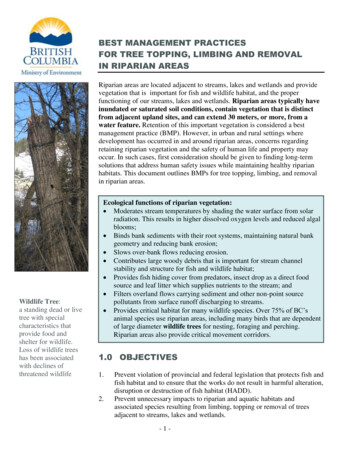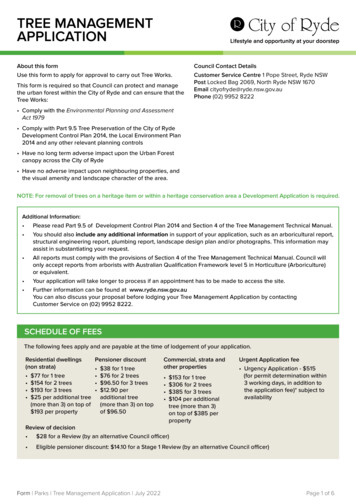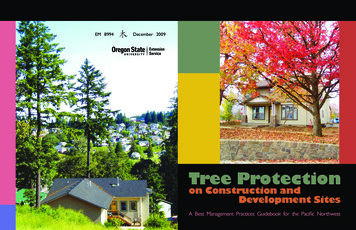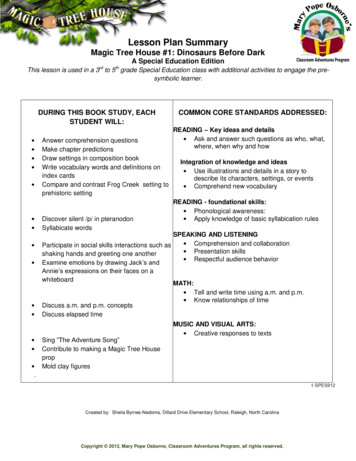
Transcription
BEST MANAGEMENT PRACTICESFOR TREE TOPPING, LIMBING AND REMOVALIN RIPARIAN AREASRiparian areas are located adjacent to streams, lakes and wetlands and providevegetation that is important for fish and wildlife habitat, and the properfunctioning of our streams, lakes and wetlands. Riparian areas typically haveinundated or saturated soil conditions, contain vegetation that is distinctfrom adjacent upland sites, and can extend 30 meters, or more, from awater feature. Retention of this important vegetation is considered a bestmanagement practice (BMP). However, in urban and rural settings wheredevelopment has occurred in and around riparian areas, concerns regardingretaining riparian vegetation and the safety of human life and property mayoccur. In such cases, first consideration should be given to finding long-termsolutions that address human safety issues while maintaining healthy riparianhabitats. This document outlines BMPs for tree topping, limbing, and removalin riparian areas.Wildlife Tree:a standing dead or livetree with specialcharacteristics thatprovide food andshelter for wildlife.Loss of wildlife treeshas been associatedwith declines ofthreatened wildlifeEcological functions of riparian vegetation: Moderates stream temperatures by shading the water surface from solarradiation. This results in higher dissolved oxygen levels and reduced algalblooms; Binds bank sediments with their root systems, maintaining natural bankgeometry and reducing bank erosion; Slows over-bank flows reducing erosion. Contributes large woody debris that is important for stream channelstability and structure for fish and wildlife habitat; Provides fish hiding cover from predators, insect drop as a direct foodsource and leaf litter which supplies nutrients to the stream; and Filters overland flows carrying sediment and other non-point sourcepollutants from surface runoff discharging to streams. Provides critical habitat for many wildlife species. Over 75% of BC’sanimal species use riparian areas, including many birds that are dependentof large diameter wildlife trees for nesting, foraging and perching.Riparian areas also provide critical movement corridors.1.0 OBJECTIVES1.2.Prevent violation of provincial and federal legislation that protects fish andfish habitat and to ensure that the works do not result in harmful alteration,disruption or destruction of fish habitat (HADD).Prevent unnecessary impacts to riparian and aquatic habitats andassociated species resulting from limbing, topping or removal of treesadjacent to streams, lakes and wetlands.-1-
2.0 BEST MANAGEMENT PRACTICES FORHAZARD TREESRefer to Section 5.0 –Legislation forlegislation that mayapply to wildlife trees.The following best management practices (BMPs) address the planning andoperation stages. It is advisable to retain a qualified professional to assist inplanning and to ensure all legislative requirements are followed.2.1Hazard tree? – Determine if the tree qualifies as a ‘Hazard’. Livehazard trees should be assessed and designated as such by:i)a ‘Qualified Environmental Professional’ (QEP) as required bythe Riparian Areas Regulation (RAR) – Refer to Section 5.2; orii) a qualified arborist certified as a Wildlife Danger Tree Assessorwhen RAR is not applicable.Refer to Section 4.0 “Non-Hazard Trees” if the tree/s have beenassessed as “non-hazard” trees.Hazard trees may be removed or limbed without authorization fromprovincial or federal authorities by following the remaining operationalBMPs and provided that:i) a QEP determines no HADD will occurORii) the hazard is limited to a few dead trees;ANDiii) the tree does not contain a nest of a heron, eagle, osprey, peregrinefalcon or gyrfalcon (per Wildlife Act);iv) the activity necessitating the tree removal does not require a RARAssessment under the Riparian Areas Regulation; and(http://www.env.gov.bc.ca/habitat/fish protection )v) a bird or its egg, or an occupied nest (see 2.3 below)Hazard Tree:any tree that is hazardousto people or facilitiesbecause of location, lean,physical damage,overhead hazards,deterioration of limbs,stem or root system, or acombination of these.Example: Hazard treelimb over target.2.2Limbing/topping – Where safe, the preferred option is limbing ortopping rather than removing the entire tree.i)Top trees to a minimum of 3-5m in height or as tall as isreasonably safe (i.e. shorter than the distance to the nearestpossible target, such as a building).ii) Leave a large branch on the stub to provide perching habitat.2.3Wildlife tree? A qualified professional can determine if the proposedtree removal is providing wildlife habitat. Vegetation removal is to betimed to avoid affecting trees used by all birds or wildlife while they arebreeding, nesting, roosting or rearing young. See Section 34 of theWildlife Act.-2-
Choose native plantssuited to the siteconditions (i.e. suitedto the biogeoclimaticsub zone and siteseries). Adjacentundisturbed riparianareas can be used asreference areas forsuitable species.2.4Reduce your impact – limit vegetation removal to only that area whichis required to avoid a hazard. Maximize tree and shrub understoryretention. Minimize the potential for invasive plant infestation.2.5Falling – Avoid falling, limbing or topping trees into a stream, lake orwetland. Accumulations of fine materials and branches may block flowsand are to be removed by hand. Options for falling trees in sectionsand/or crane-assisted removals are to be considered first. Trees may befelled across or into a water body ONLY where no other method of treeremoval is possible due to safety concerns.2.6Retain large woody debris and the stubs of large diameter trees - themost valuable stubs and large woody debris is greater than 10 cmdiameter and longer than 3 meters. Where required, small branches andlimbs may be removed offsite to reduce fire hazards.2.7Replant with native species of trees, shrubs and herbaceous plantsecologically suited to the site conditions. Where entire trees have beenremoved the tree replacement criteria is to be /forms/vegetation riparian/treereplcrit.pdf)2.8Prevent contamination – all equipment used for vegetation removaland management should comply with BMPs to prevent the discharge ofdeleterious substances into water bodies. For the purposes of this BMP itis assumed that all works will take place above the high water mark(HWM). Works below the HWM require Water Act permits and couldalso result in a HADD.i)Ensure equipment and machinery is in good operating condition(power washed), free of leaks or excess oil and grease.ii) No equipment refuelling or servicing should be undertakenwithin 30 metres of any watercourse or surface water drainage.iii) Ensure all hydraulic machinery to be used around streams isclean and uses environmentally sensitive hydraulic fluidswhich are non-toxic to aquatic life, and which are inherently biodegradable.iv) Keep a spill containment kit readily accessible onsite in the eventof a release of a deleterious substance to the environment.2.9Timing windows – If proposed works pose risks to fish and wildlife andtheir habitat, then the works are to take place during the instream worksreduced risk timing window provided by the regional Ministry ofEnvironment (MOE) indows.html-3-
2.10Retain records to demonstrate compliance with BMPs and duediligence in meeting the requirements of applicable legislation. Photodocumentation prior to and after completion of works may be requestedduring follow-up monitoring by MOE or Fisheries and Oceans Canada(DFO) staff.3.0 PINE BEETLE INFESTATIONIn cases of large scale die offs due to pine beetle infestation, all hazard trees can be removedfrom the riparian area. Some of the trees within the riparian buffer should be retained as stubs toallow them to function as wildlife trees. The greater the diameter of the tree, the more species itcan support. To maximize remaining riparian function, non target trees and shrub understory isto be retained. This is especially important where large areas of the riparian buffer have beenimpacted by beetle kill. BMPs listed in Section 2.0 also apply to removal of pine beetle killedtrees, including legislative requirements such as Riparian Areas Regulation (RAR). For moreinformation on RAR check with the local government or refer to Section 5.2.4.0 NON-HAZARD TREESThe BMP for non-hazard trees is to avoid topping, limbing or removal. Removal of non-hazardtrees from riparian areas bordering waterbodies that support fish habitat may result in a violationof the Fisheries Act and/or Riparian Areas Regulation. Non-hazard trees should only be removedif they have been designated for removal under a government pest control program. To avoidcontravention of the Fisheries Act, prior to removal, you should consider engaging the servicesof a qualified professional to develop mitigation strategies to ensure a HADD of fish habitat willnot occur as a result of proposed non-hazard tree removals. Refer to the chart below forprocedures required when proposing to remove non-hazard trees in riparian areas providing fishhabitat.Note: a Qualified Professional (QP) includes Qualified Environmental Professional (QEP),which is applicable where the Riparian Areas Regulation is in effect.QP requiredQP develops mitigative strategies toensure a HADD of fish habitat will notoccur as a result of proposed nonhazard tree removal.Mitigative strategies are not sufficient toavoid a HADD Remove trees according tooperational BMPS Follow QP site-specificrecommendationsQP develops a rationale and compensatory habitat proposal forsubmission to DFO. Report should include: Rationale for proposed non-hazardous vegetation removal Number and location of proposed tree and/or shrub removals Replacement plantings plan Survival monitoring plan for replacement plantings-4-
5.0 APPLICABLE LEGISLATION5.1Local GovernmentContact your local municipality or regional district to find out which local bylaws may apply toyour proposed works.5.2Provincial LegislationWater Act and RegulationsAll works proposed in and about a stream, below the high water mark, are subject to the WaterAct and require authorization by the MOE. Additional information is available at:http://www.env.gov.bc.ca/wsd/water rights/licence application/section9/index.htmlWildlife Act, 2004The Wildlife Act prohibits the killing, harming, harassment, capture or taking of species at riskand the damage or destruction of a residence of a species at risk except as authorized byregulation, permit or agreement. The Act also protects all birds and their eggs; nests while theyare occupied by a bird or egg; and the nests of eagles, peregrine falcons, gyrfalcons, ospreys,and herons year-round. http://www.qp.gov.bc.ca/statreg/ stat/W/96488 01.htm.Riparian Areas Regulation, 2004Through local government legislation, RAR protects riparian areas and their features, functionsand conditions during residential, commercial, and industrial development and ancillaryactivities. Additional information is available athttp://www.env.gov.bc.ca/habitat/fish protection act/riparian/riparian areas.htmlCheck with your local government on requirements for a RAR Assessment. If the localgovernment has not currently fully implemented RAR we advise you to ensure that yourproject is in compliance with this legislation. This assessment (completed by a QEP)delineates a Streamside Protection and Enhancement Area (SPEA) setback necessary toavoid a HADD of fish habitat. The QEP will be able to best direct any hazard treemanagement in accordance with applicable legislation.5.3Federal LegislationFisheries ActThe Fisheries Act provides protection for all fish and fish habitat in Canada by prohibiting theharmful alternation, disruption or destruction (HADD) of fish habitat that is not authorized inadvance by Fisheries and Oceans Canada (DFO). Depositing sediment or any other‘deleterious substance’ into streams supporting fish is also prohibited. Additional cations/publications e.htm-5-
Species at Risk ActThe Species at Risk Act provides for the legal protection of designated wildlife species and theconservation of their biological diversity. Before planning any work, review the websitehttp://www.env.gov.bc.ca/atrisk/ for further information on the species at risk in your area.The Conservation Data Centre is a provincial resource that can help you to find out whatspecies at risk may be in your area (http://www.env.gov.bc.ca/cdc/). Lack of species data doesnot confirm the absence of species at risk in that area.6.0 FURTHER INFORMATIONInternational Society of Arboriculture (ISA) - information on assessing tree health and treecare can be found at http://www.treesaregood.com/Urban Tree Risk Management: A Guide to Program Design and Implementation –comprehensive document outlining practices around tree care and assessment and includes asection on wildlife values. e & Trees in British Columbia 2006 Fenger, Manning,Cooper, Guy & Bradford, LonePine PublishingBirds of the Okanagan Valley, British Columbia 1987: Cannings et. al., The Royal BritishColumbia Museum, Victoria B.C.Bald Eagles and Ospreys Fact Sheet #10 - Develop With withcare2006/develop with care intro.htmlGreat Blue Herons Fact Sheet #11 - Develop With withcare2006/develop with care intro.html-6-
- 3 - 2.4 Reduce your impact - limit vegetation removal to only that area which is required to avoid a hazard. Maximize tree and shrub understory retention. Minimize the potential for invasive plant infestation. 2.5 Falling - Avoid falling, limbing or topping trees into a stream, lake or wetland.











